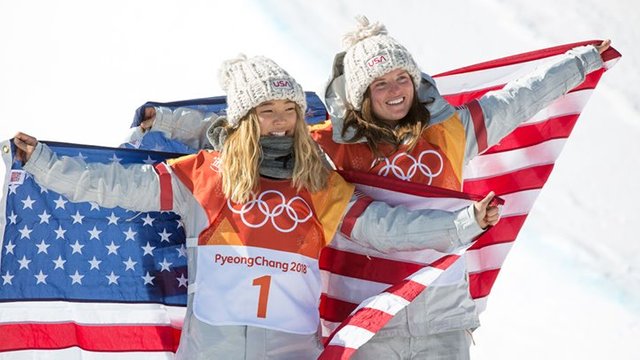What Do Olympic Athletes Really Eat, and Are Their Diets Healthy?

February 15, 2018
Ever since we heard that the Olympic swimmer Michael Phelps eats 12,000 calories a day during training, we’ve been fascinated by the diets of Olympic athletes. Luckily, they’re not shy about sharing their eats on social media as they compete in the winter games in Pyeongchang, South Korea.
You’ll find that their diets look … normal. The speed skater Joey Mantia posted a photo to Twitter in which he’s sitting down to eat a plate of noodles.
Joe Polo, a curler, noshed on some sushi before the start of the games: “Sushi in Japan was everything I expected. Glad we got to go out our last night here with the team #notsurewhatsomeofitwas.”
The alpine skier Ted Ligety is all over Instagram chowing down on Oreos and drinking Folgers coffee. (Folgers is a sponsor; Oreo was an #ad.)
Still, their diets can be demanding, thanks to all the calories they burn through training. Resi Stiegler, another alpine skier, eats every 90 minutes, and many athletes consume between 3,000 and 4,000 calories a day, ABC News reports.
RELATED: 10 Essential Facts About Metabolism and Weight Loss
But top-notch athletes aren’t eating healthy all the time. The gold-medal-winning snowboarder Chloe Kim recently posted on Twitter about her love for churros:
“Oh and I also had 2 churros today and they were pretty bomb so if you ever get nervous go eat a churro.”
She’s also talked about eating a breakfast sandwich — and the plight of being hangry, which we can all relate to.
The Today show put up a video on Twitter detailing what Olympic athletes eat for breakfast — and it ranges from the trendy to the traditional. For instance, a female ice hockey player sits down to a power bowl of greens, tomato, avocado, beets, lentils, sweet potato, and an egg. For a female snowboarder, it’s Cinnamon Toast Crunch cereal. (Then there’s the male skier who eats applesauce with protein powder mixed in.)
RELATED: The Best Breakfast Cereals for Weight Loss
If you want to get an inside peek into what they’re being served in Pyeongchang, Team USA Sports Nutrition’s Instagram shows it like it is. One pic features a tray of an egg scramble offered to figure skaters.
“Interested in what the figure skaters in PyeongChang have available to eat at their competition venue? #pyeongchang2018 #usafigureskating #medalcount”
Why Olympic Athletes Make the Diet Choices They Do
It’s probably no shocker that these athletes need to eat — and they need to eat well. “What they’re eating and their calorie needs differ greatly by sport. A figure skater will have different nutrition needs compared with a bobsledder,” says Amy Goodson, RD, a Dallas-based sports nutritionist. She works with some figure skaters, noting that they often train for four hours in the morning and then two to three hours in the afternoon. “That’s a lot of training. We use an equation that takes into account their height, weight, age, gender, and activity level to get their caloric needs,” she says.
The goal is to fuel for performance. “For example, a [long-distance] athlete, such as a cross-country skier, may require up to 7,000 calories or more per day to support the demand of the sport, while an athlete participating in a sport with a shorter duration, like ski jumping, may only require around 2,000 calories per day,” says Kacie Vavrek, RD, a sports dietitian at the Ohio State University Wexner Medical Center in Columbus.
RELATED: The Benefits of Strength and Weight Training
While many events are endurance-based, they also require short bouts of high intensity activity, Goodson points out. Overall, an Olympic diet is a generally healthy diet featuring a mixture of carbohydrates (for energy), protein (to build lean body mass and stabilize blood sugar for satiety), and omega-3 healthy fats like fatty fish and flaxseeds (to quell inflammation for recovery and increase calories). Plus, lots of fruits and veggies for their antioxidants. “The more nutrient-rich the diet eaten, the better the athletes are able to recover after training,” she says.
And yes, there are churros and Oreos here and there. But athletes at the top of their sport don’t want to feel bogged down by a huge meal. “After you have a burger, who wants to skate after that?” Goodson says. While they can afford to eat more calories, they also tend to choose better sources, like avocados, trail mix, and nut butters.
Should You Eat Like an Olympic Athlete? Why or Why Not?
Goodson recommends the 80/20 rule for everyday folks and athletes. That’s when you go with healthy choices 80 percent of the time and leave 20 percent of the time for “fun foods.” An athlete may rein that in to 90/10 the closer they get to competition.
Should you eat like an Olympian? Yes and no.
Unless you’re training multiple hours a day for an event, you probably don’t need to eat the calorie load they do. “If an everyday person consumed 5,000 to 8,000 calories in a day, it would likely lead to significant weight gain, even if they exercised regularly,” says Vavrek. Plus, these athletes are working with sports dietitians to make sure their diets are on point.
For those of us who exercise but aren’t Olympic athletes, the same general nutrition principles apply: "Eat an overall balanced diet with a variety of vegetables, fruit, lean protein sources, whole grains, and healthy types of fats,” says Lynn Grieger, RDN, CDE, a Prescott, Arizona–based sports nutritionist and certified personal trainer for the diet app Rise. Grieger is also a medical reviewer for Everyday Health.
Boost Your Post. Send 0.100 STEEM or SBD and your post url on memo and we will resteem your post on 5000+ followers. check our account to see the follower count.